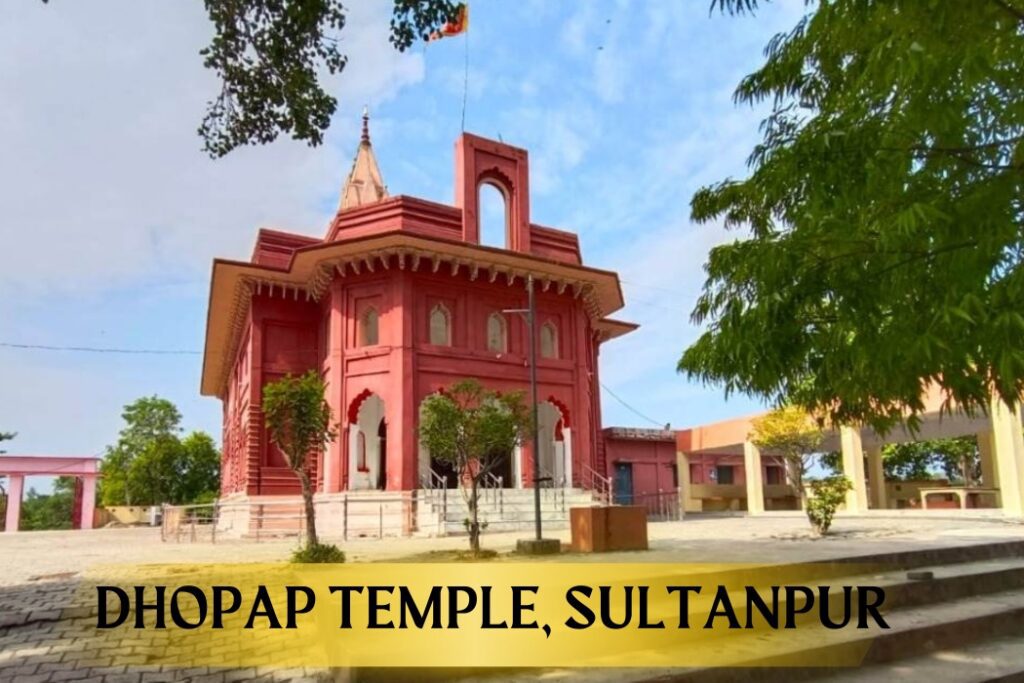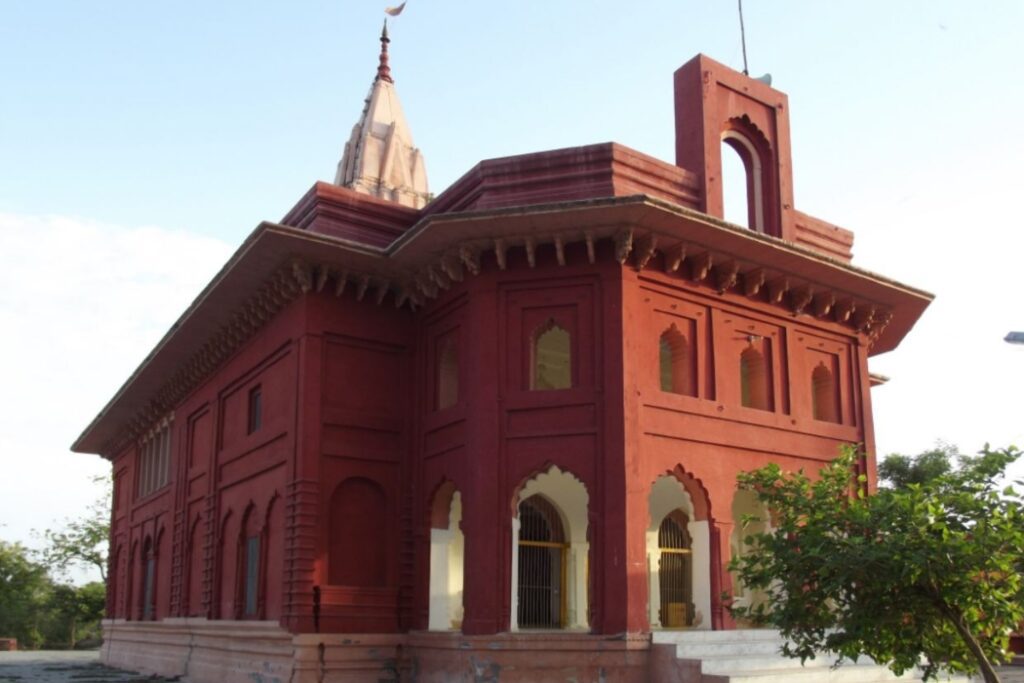Dhopap Temple, Sultanpur: History, Significance, and Travel

Dhopap Temple, Sultanpur: Located in Sultanpur, Uttar Pradesh, the Dhopap Temple, also called Dhopeshwar Nath Temple, is situated in the centre. This historic location attracts followers of Lord Shiva, a highly respected deity in Hinduism. Dhopap Temple, with its rich historical background and distinct architecture, goes beyond the traditional concept of a place of worship, providing an enchanting visit for people of any religious belief.
It is thought to be more than 2,000 years old, originating from the Mauryan Empire, and contains many sanctuaries honouring different Hindu gods like Lord Hanuman and Goddess Durga.
This blog discusses the history, architecture, wonderful attractions, and sense of tranquility that make Dhopap Temple Sultanpur an excellent destination to visit.
| Participate in online puja organised by VAMA (Get the puja done with your name and gotra) | |
| Name of Puja | Temple (Place) |
| Rin Mukti Puja | Rin Mukteshwar Mahadev Temple (Ujjain) |
| Tantra Badha Mukti Bhairav Mahasuraksha Yagya | Vikrant Bhairav Mandir,Ujjain |
| Shani Sade Sati | Shani Shingnapur Devsthanam ,Maharashtra |
| Vyapar Vriddhi Mahalakshami Puja Evam 108 Kanak Stotra Path | Mahalakshmi Temple,Maharashtra |
| Rahu Grah Shanti Puja | Jarkutinatheshwar Mahadev Temple, Prayagraj |
| Rahu-Ketu Shanti Puja | Rahu Temple, Paithani, Uttarakhand |
Read this Blog to know about Alopi Devi Temple – Alopi Devi Mandir, Prayagraj: History, Significance, and Travel
History and Story Behind the Dhopap Temple
The tale narrates the story of Lord Rama, a renowned king celebrated for his virtuousness. Lord Rama was in a bind after overcoming king Ravana in Lanka. Despite being a demon, Ravana was also a Brahmin. Taking the life of a Brahmin, even during a fight, is considered a wrong act known as Brahmahatya.
Rama’s spiritual guide, his lineage guru, understood the situation’s gravity. He consulted other wise sages for advice. After much discussion, they came up with a unique solution.
They took a black crow, a symbol of bad luck or negativity, and placed it on a leaf. They then set it afloat on the Gomti River. Everyone watched as the crow drifted downstream. Miraculously, when the crow reached a specific spot, it turned white! This transformation from black to white was seen as a sign. The sages believed the location had special cleansing powers. They declared this place suitable for Rama to bathe and be absolved of the sin of Brahmahatya.
The spot where the crow turned white is now known as Ramghat. It’s considered a holy place, especially for those seeking purification. Every year, on a specific date, a large gathering of devotees takes place at Ramghat. People come not just from nearby areas but also travel from faraway districts to bathe in the holy water, seeking spiritual peace and cleansing.

Architecture of Dhopap Temple
The Dhopap Temple has a unique architectural layout that houses a number of deities. The heart of the temple is the sanctum sanctorum, dedicated to Lord Rama and his royal court. Here, devotees find idols of Lord Rama, his wife Sita, his brothers Lakshmana, Bharata, and Shatrughna, creating a sense of completeness and regal presence. According to the Gazetteer, this central chamber may also house idols of Radha and Krishna, further enriching the spiritual experience.
Guarding the entrance to the sanctum sanctorum are statues of the mighty Hanuman, Lord Rama’s loyal devotee. This placement signifies Hanuman’s unwavering devotion and role as a protector. The architectural beauty extends beyond the central sanctum.
A dedicated shrine to Lord Shiva resides here. This chamber features a rare stone Shivling along with an idol of Lord Ganesha, the remover of obstacles. This chamber enshrines the powerful Goddess Durga and a four-armed representation of Lord Vishnu, the preserver of the universe.
Spiritual Significance and Festivals
At Ganga Dussehra, worshippers assemble to take part in unique rituals. Priests recite sacred verses and pray to receive the Ganges’ blessings for cleansing and abundance.
The temple could arrange special lectures or speeches regarding the importance of the Ganges river and its significance in Hinduism.
Chaitra Ram Navami honours the arrival of Lord Rama, the seventh incarnation of Vishnu. Followers honour the appearance of Lord Rama on earth and his virtuous journey.
Special pujas and elaborate abhishek ceremonies bring the Dhopap Temple to life.
The temple could plan cultural events such as bhajans.
Tourist attractions around the Dhopap Temple
Ancient tree in the Jila Udyog Kendra campus is the Parijaat Vriksh. The community holds the belief that the tree, which is several hundreds of years old, is a sacred tree that is highly revered.
The Gomti Riverfront provides a peaceful environment to relax and enjoy the stunning natural scenery. You can either go on a boat ride on the river or unwind on the riverbank and enjoy the peacefulness.
Shree Chitragupt Dham is a religious site dedicated to honoring Shri Chitragupt Maharaj, the god of Justice. Situated on the banks of the Gomti River, it is a famous destination for spiritual pilgrimages.
Bijethua Mahaviran Temple is a famous place of pilgrimage, especially crowded on Tuesdays and Saturdays.
Popular resort located on the banks of the Gomti River: Chalet Resort. Various options for activities are offered such as boating, fishing, and swimming.
How to Reach the Dhopap Temple?
Flying to Sultanpur – Allahabad Airport (IXD) is approximately a 2-hour drive away. Air India mainly provides flights departing from major cities such as Delhi.
Sultanpur has its very own railway station, which is called Lambhua Railway Junction (LHU). This station connects Sultanpur with major cities like Lucknow, Kanpur, Delhi, and states like Jaipur and Bhopal.
Both UPSRTC and private travel companies provide bus services from Sultanpur to different cities. Faizabad is a popular destination for tourists within a 60 km radius, along with Allahabad at 103 km, Lucknow at 135 km, Varanasi at 162 km, Kanpur at 231 km, and Delhi at 630 km.
The Dhopap Temple in Sultanpur, Uttar Pradesh, is both a religious site and an intriguing historical attraction. This historic structure, thought to be older than 2,000 years, serves as more than just a regular place of worship, providing a diverse mix of history, architecture, and spiritual importance.

Want to know about Bhimashankar Jyotirlinga? Read this blog – Bhimashankar Jyotirlinga, Pune: History, Significance, and Travel




